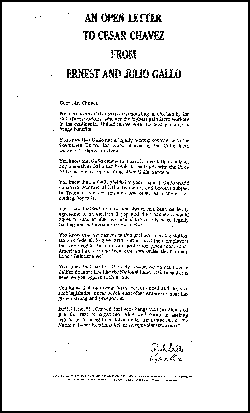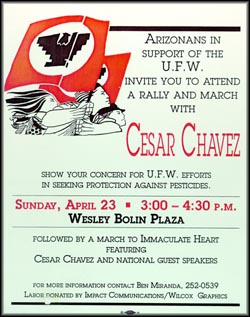|
C�sar Estrada Ch�vez was one of the great pioneers of civil and
human rights. He was born in 1927 on a family farm near Yuma,
Arizona to a poor Mexican American family that barely earned a
living on marginal land. During the Great Depression, the Ch�vez
family lost its land through a tax sale and was forced to join the
migrant stream that flowed from harvest to harvest fields of
commercial crops. Young C�sar grew up in the shacks of farm labor
camps, attended thirty different schools, and eventually reached
the seventh grade.
After serving two years in the Navy towards the end of World
War II, he met and married his wife Helen Fabela, in 1948. By
1958, Ch�vez began advocating for the development of a farm labor
organization. With the help of Dolores Huerta and Gilbert
Padilla, Ch�vez organized the United Farm Workers (UFW),which was
organized in 1962 as the Farm Workers Association (FWA). By 1965,
the organization had grown to include fifty chapters throughout the
San Joaquin Valley, won its first successful strike and had changed
its name to the National Farm Workers Association (NFWA).
Ch�vez merged the NFWA with the Agricultural Workers Organizing
Committee (AWOC) to form with the AFL-CIO the United Farm Workers
Organizing Committee (UFWOC) which initiated a general grape boycott
and claimed a victory in 1969 when major table-grape growers signed
three-year union contracts with UFWOC.
By 1967, Ch�vez attempted to unionize agricultural workers in
efforts to call attention to the plight of farm workers through
boycotts and labor strikes. United Farm Workers Organizing Committee (UFWOC)
changed its name to the United Farm Workers (UFW) and as a labor union,
affiliated with the AFL-CIO. During the mid-1970s, the UFW sent
labor organizers throughout the United States to begin similar
unionization efforts, and it was during this period that the
Arizona Farm Workers (AFW) was established. However, Arizona's
conservative leaders and their political maneuvers made it difficult
for organizers to unionize farm workers, and they met with defeat
in their attempts to do so.
For his humanitarian contributions and his work on behalf of farm
workers, the down-trodden, the poor, and the families who toil the
soil and suffer from the dangers of pesticides, Arizona State
University awarded C�sar Estrada Ch�vez an Honorary Doctor of
Humane Letters degree in commencement ceremonies on May 8, 1992.
On April 22, 1993, C�sar Estrada Ch�vez died in his sleep in Yuma,
Arizona, a few hours after finishing his second day of court
testimony in a trial defending the United Farm Workers (UFW) union
in a suit brought against it by Bruce Church, Inc., a vegetable
produce company in Salinas, California. Throughout his life, however, C�sar
Ch�vez acknowledged his Arizona birthright and often recalled his
family's struggles as workers in the fields.
|
|

Cesar Estrada Chavez
N.D.
ACC# 98-1982
Martha Mitten Collection

Open letter to Cesar Estrada Chavez/
Carta abierta para César Estrada Chávez
1970s
Acc# 98-1982
Marth Mitten
Collection

Poster: Meeting in Arizona.

Bumper Sticker/
1969
ACC#98-1982
Martha Mitten Collection
|
|
C�sar Estrada Ch�vez fue uno de los grandes pioneros que lucharon
por los derechos civiles y humanos. Naci� de una familia pobre
de procedencia Mexicana Americana en 1927 en una hacienda pobre
de la familia cerca de Yuma, Arizona; una familia que escasamente
se ganaba la vida en una tierra que casi no produc�a. Durante
la gran depresi�n, la familia Ch�vez perdi� su tierra debido a
los pagos de impuestos y la familia se vio forzada a reunirse
con la multitud de migratorios que flu�an de cosecha en cosecha en
los campos de cultivos comerciales. El joven C�sar creci� en chozas
campesinas en haciendas de labor; asisti� 30 escuelas diferentes y
eventualmente lleg� hasta el s�ptimo grado.
Despu�s de servir dos a�os en la marina, hacia finales de la
Segunda Guerra Mundial, �l conoci� y se cas� con su esposa Helen
Fabela en 1948. Alrededor de 1958, Ch�vez comenz� a defender el
desarrollo de una organizaci�n de labradores. Con la ayuda de
Dolores Huerta y Gilbert Padilla, Ch�vez organiz� la Uni�n de
Trabajadores de Hacienda/United Farm Workers (UFW), la cual fue
organizada en 1962 como la Asociaci�n de Trabajadores de
Hacienda/Farm Workers Asociation (FWA). Alrededor de 1965, la
organizaci�n hab�a crecido hasta cincuenta cabildos a trav�s del
Valle San Joaqu�n y gan� exitosamente su primera huelga, cambiando
su nombre a Asociaci�n Nacional de Trabajadores de Hacienda
(National Farm Workers Association - NFWA).
Ch�vez fusion� la NFWA con el Comit� Organizador de Trabajadores
Agr�colas (Agricultural Workers Organizing Committee - AWOC), que
inici� un boicoteo general de las uvas y declar� victoria en 1969
cuando un criador de tabla mayor de uvas firm� contratos de uni�n
por tres a�os con UFWOC.
Alrededor de 1967, Ch�vez trat� de unificar a los agricultores
en un esfuerzo por llamar la atenci�n por la situaci�n dif�cil de
los labradores a trav�s de boicoteos y huelgas de labor. Comit� Organizador
de Labradores Unidos (United Farmworkers Organizing Commettee - WFWOC) cambi� su nombre a Trabajadores de Hacienda Unidos
(United Farm Workers - UFW) y por ser una uni�n de labor, se afili�
con AFL-CIO. Durante mediados de 1970, la UFW envi� organizadores
de labor a trav�s de los Estados Unidos para iniciar esfuerzos
similares de unificaci�n, y fue durante este per�odo que se
estableci� Trabajadores de Hacienda de Arizona (Arizona Farm Workers - AFW).
Sin embargo, los l�deres conservadores y sus maniobras pol�ticas hicieron
dif�cil que los organizadores unificaran a los labradores y
encontraron la derrota al tratar de hacerlo.
Por sus contribuciones humanitarias y su trabajo en beneficio de los
agricultores, los oprimidos, los pobres, y las familias que trabajaron
las tierras y sufrieron por los peligros de los pesticidas, la
Universidad del Estado de Arizona otorg� a C�sar Estrada Ch�vez el
grado de Doctor Honorario de Cartas Humanitarias en las ceremonias
de graduaci�n el 8 de mayo de 1992. El 22 de abril de 1993, C�sar
Estrada Ch�vez muri� mientras dorm�a en Yuma, Arizona, unas horas
despu�s de haber terminado su segundo d�a en un testimonio en la
corte en un juicio en el que se defend�a a la uni�n de los
Trabajadores de Hacendados Unidos (UFW), un juicio seguido en contra de
la uni�n por Bruce Chuch, Inc., una compa��a de producci�n de vegetales
en Salinas, California. A trav�s de su vida,
sin embargo, C�sar Ch�vez, reconoci� sus derechos de nacimiento en
Arizona y muy a menudo record� las luchas de su familia como
trabajadores del campo.
|
 Home Page
Home Page
 Ranching/Ganadería
Ranching/Ganadería
 Mining/Minería
Mining/Minería
 Agriculture/Agricultura
Agriculture/Agricultura
 Organizations/Organizaciones
Organizations/Organizaciones
 Family & Community/La Familia y La Comunidad
Family & Community/La Familia y La Comunidad
 Occupations/Ocupaciones
Occupations/Ocupaciones
 Landmarks/Marcas de Linderos
Landmarks/Marcas de Linderos
 Credits/Cr�ditos
Credits/Cr�ditos
 References/Referencias
References/Referencias
 Evaluation/Evaluaci�n
Evaluation/Evaluaci�n













